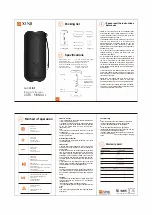
XSL rigging modes - 2 in 1
The XSL rigging system allows for two different rigging modes:
▪
Þ
Compression mode,
▪
Þ
Tension mode,
▪ or a combination of both, depending on the array length and
the compression force required.
2.1 Rear rigging strand
Splay link, Locking pins and hole grids
The Splay link on the rear rigging strand of the XSL TOP cabinet is
equipped with a slotted hole
[S] which allows for either
Compression or Tension mode setup without any further
modification to the cabinet.
For this purpose, the rear rigging strand provides three Locking
pins and three dedicated hole grids.
The bi-colored label (black/blue on XSL8 and black/grey on
XSL12 cabinets) simplifies the assignment of the appropriate hole
grid to the respective rigging mode.
The inner hole grid (colored area
Þ
) is used in
Compression mode while the outer hole grid (black area
Þ
) is used in Tension mode.
The center hole grid applies to both rigging modes providing the
odd splay angles in Compression mode and the even splay angles
in Tension mode.
Locking pin conventions
Pin [1]
Pin [2]
Compression mode:
In Compression mode, pins
[1] and [2] (Safety pin)
are
always inserted into the 0°/2° holes at the top
of the center hole grid of all cabinets (
Þ
Red labeled
holes -
).
Tension mode:
In Tension mode, pin
[1] is used to preset the splay
angle (e.g. 2° as shown in the graphic opposite) of a
certain cabinet on the center and outer hole grid of
the cabinet itself. During hoisting, the Splay link of the
upper cabinet will engage and safety pin
[2] is
inserted in the hole directly below.
Pin [1]/[2] convention
Compression | Tension mode
2 XSL rigging modes - 2 in 1
d&b XSL Rigging manual 1.1 en
- preliminary -
6







































